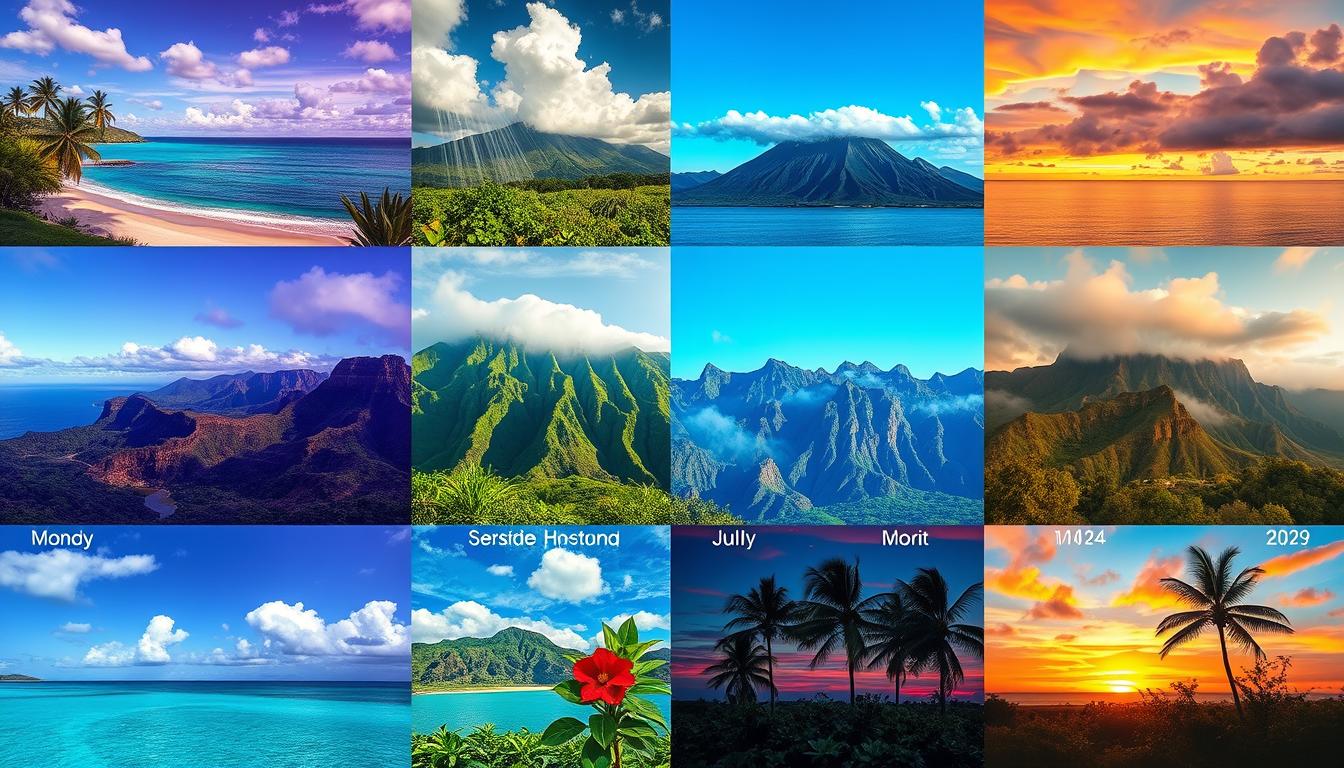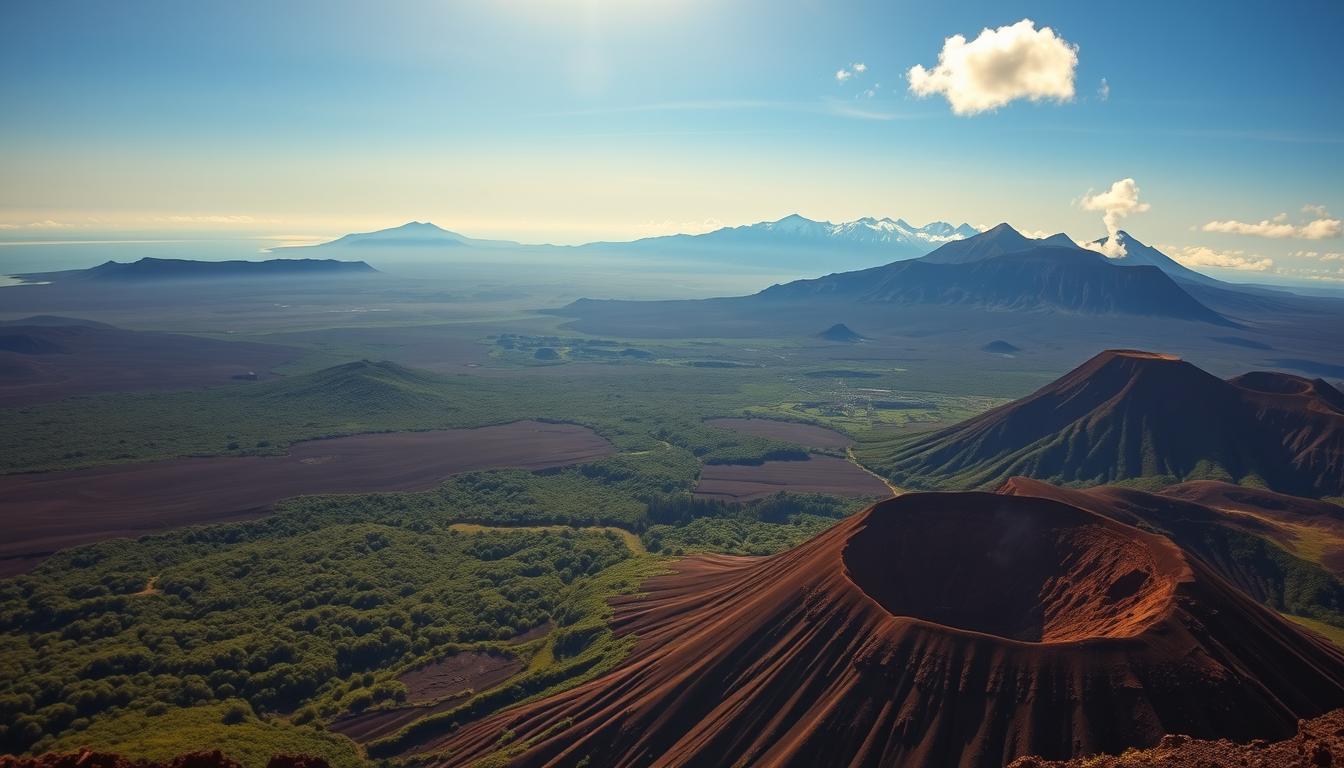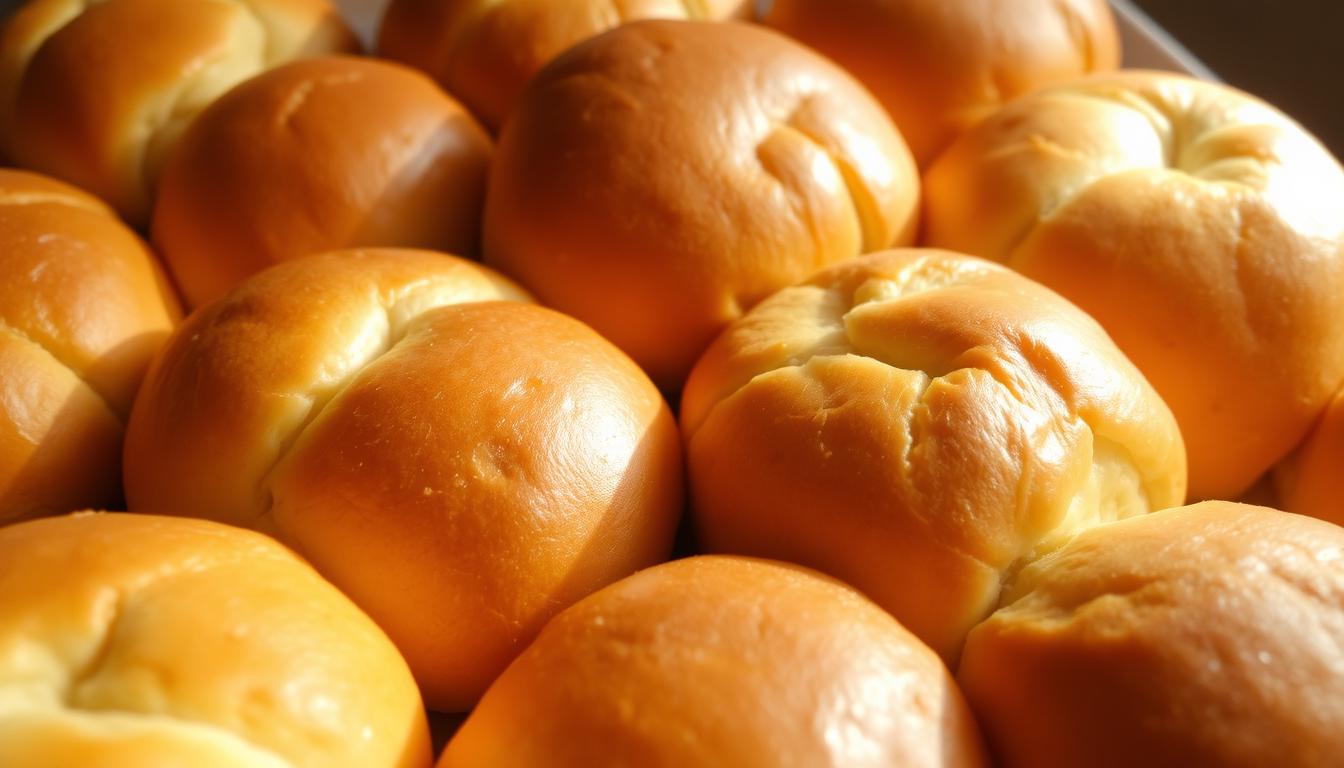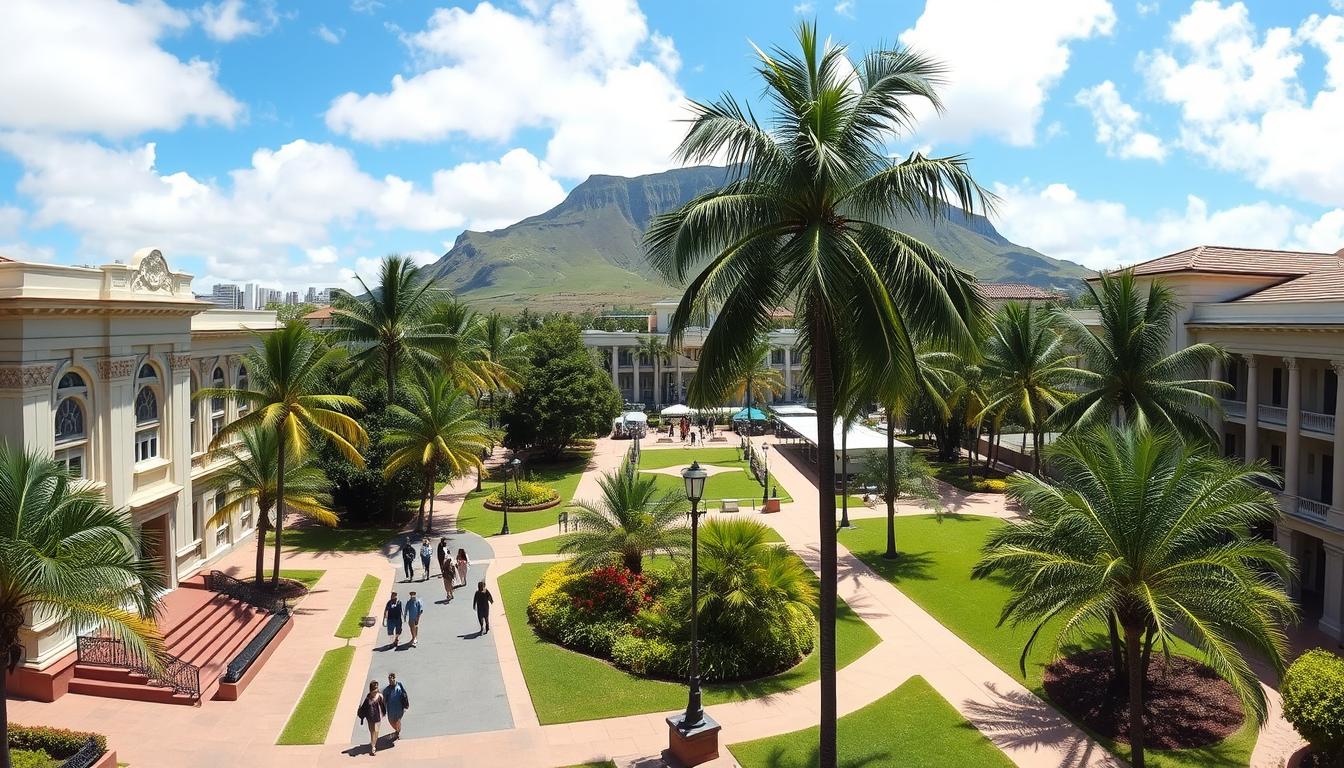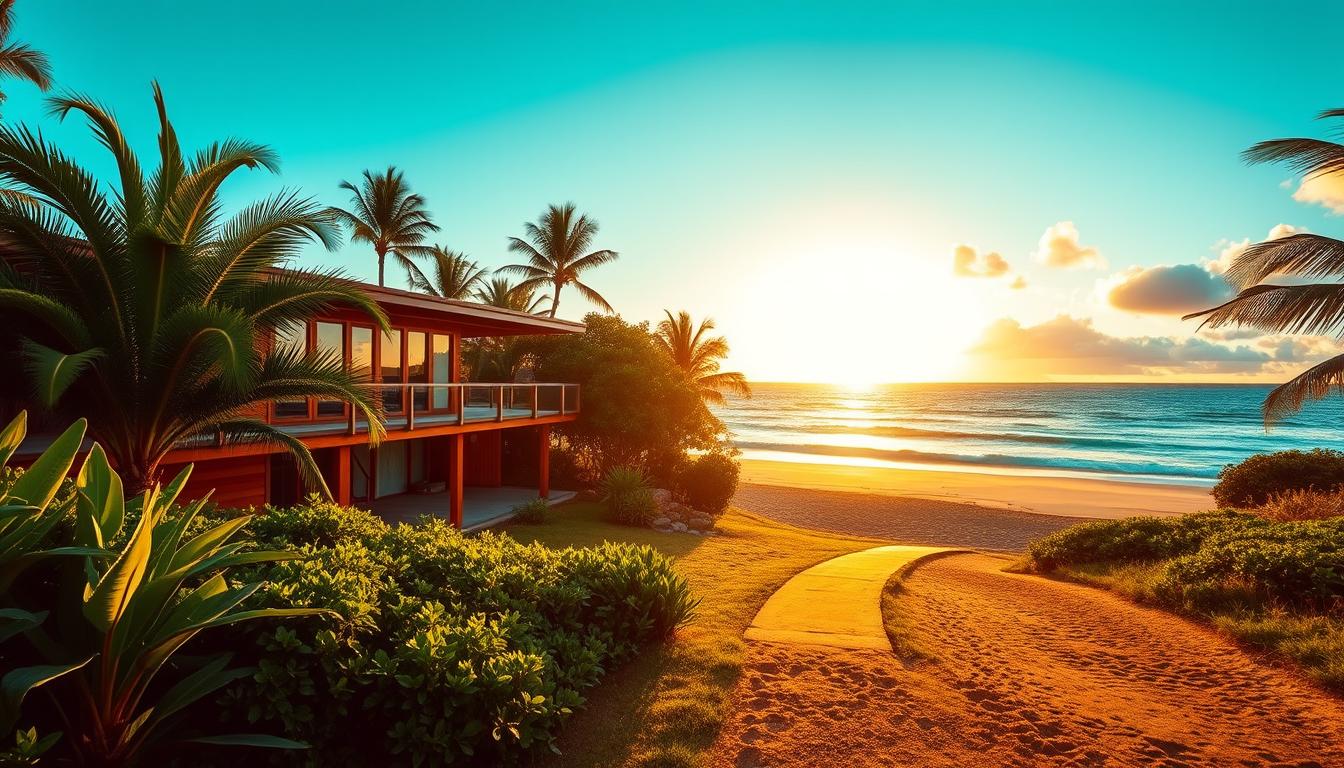Hawaii’s weather is a true delight, offering tropical temperatures and consistent warmth throughout the year. Daytime high temperatures range from a comfortable 78°F in the cooler months to a balmy 88°F in the hotter months. This makes the Hawaiian Islands a perfect escape for those seeking warm and sunny conditions.
The evenings in Hawaii are equally pleasant, with low temperatures varying from 65°F in the cooler months to a still-comfortable 75°F in the warmer months. While the months of April through October generally experience less rainfall compared to November through March, the majority of precipitation typically falls overnight. This allows visitors to enjoy sunny and dry days during their stay.
Hawaii’s diverse microclimates and volcanic landscapes create unique weather patterns across the islands. This tropical, consistent warmth is the hallmark of this Pacific paradise. From the lush, rainier windward coasts to the sunnier and drier leeward sides, each Hawaiian island offers its own distinct weather characteristics. This showcases the incredible diversity that makes this destination so captivating.
Key Takeaways
- Hawaii experiences warm temperatures year-round, ranging from 78°F to 88°F during the day
- Evening low temperatures vary from 65°F to 75°F, creating pleasant evenings
- April through October are generally drier than the rainier November through March period
- Hawaii’s diverse microclimates, influenced by trade winds and volcanic landscapes, offer unique weather patterns across the islands
- The consistent tropical warmth makes Hawaii an ideal destination to visit throughout the year
Tropical Temperatures Year-Round
Hawaii’s climate is a tropical delight, with average highs ranging from 78°F in cooler months to 88°F in warmer ones. Even on the coolest nights, temperatures rarely fall below 65°F. This warmth is due to Hawaii’s equatorial location, creating a tropical paradise filled with flowers all year.
Average High and Low Temperatures by Month
| Month | Average High | Average Low |
|---|---|---|
| January | 80°F | 66°F |
| February | 80°F | 65°F |
| March | 81°F | 67°F |
| April | 83°F | 68°F |
| May | 85°F | 70°F |
| June | 87°F | 72°F |
| July | 88°F | 73°F |
| August | 88°F | 74°F |
| September | 88°F | 73°F |
| October | 87°F | 72°F |
| November | 84°F | 70°F |
| December | 81°F | 67°F |
Consistent Warmth Throughout the Year
Hawaii’s tropical location ensures remarkably consistent temperatures year-round. The temperature difference between the hottest and coolest months is rarely more than 10°F. This is due to ocean breezes and the absence of extreme seasonal changes. Visitors can enjoy Hawaii’s beaches, landscapes, and outdoor activities comfortably, regardless of when they visit.
Hawaii’s Diverse Microclimates
Hawaii’s varied terrain and volcanic landscapes create unique microclimates across the islands. These differences are mainly due to the trade winds and the islands’ elevations.
Windward vs. Leeward Sides
The windward sides of the Hawaiian islands are much wetter than the leeward sides. This is because the trade winds, coming from the northeast, bring moist air and more rain. In contrast, the leeward sides are drier, with a rain shadow effect from the volcanic peaks.
Elevation and Volcanic Influences
Elevation is key in shaping Hawaii’s microclimates. Volcanic mountains like Mauna Kea and Mauna Loa on the Big Island have cooler temperatures than coastal areas. As elevation increases, temperatures drop, creating different climate zones from tropical lowlands to alpine regions.
| Location | Elevation (feet) | Average Temperature (°F) | Rainfall (inches) |
|---|---|---|---|
| Honolulu (Oahu) | 13 | 80-90 | 17 |
| Haleakala (Maui) | 10,023 | 50-70 | 50-100 |
| Mauna Kea (Big Island) | 13,796 | 40-60 | 20-40 |
Oahu: Sunny Shores and City Life
Oahu, home to Honolulu and Waikiki Beach, boasts a sunny, dry climate all year. The southern and southwestern coasts, like Waikiki and Ko Olina, are famous for their sunny weather. Here, average high temperatures hit a pleasant 84°F (29°C). The North Shore also sees plenty of sunshine, but it’s known for occasional rain showers that quickly clear to the glorious Hawaiian sun.
The shoulder season, from April to May and September to October, is the best time to visit Oahu. During these months, you’ll find fewer tourists and lower prices. This makes it perfect for exploring the island’s varied landscapes and outdoor activities. Summer is the best time for the North Shore, as it’s the only season with heavy rains and strong waves.
Oahu’s temperatures stay warm all year, with summer highs in the high 80s°F (31-32°C) and winter lows in the low 80s°F (27-28°C). Honolulu and Ko’Olina tend to be warmer than the North Shore. Temperatures here rarely fall below 75°F (24°C) or rise above 90°F (32°C).
Oahu’s rainy season runs from November to March, with the heaviest rains in late fall and winter. The North Shore gets more rain than Honolulu or Ko’Olina. Hawaii’s ocean temperature ranges from about 80°F (27°C) in summer to 70°F (21°C) in winter. This makes it perfect for water activities all year.
Maui: Lush Landscapes and Scenic Drives
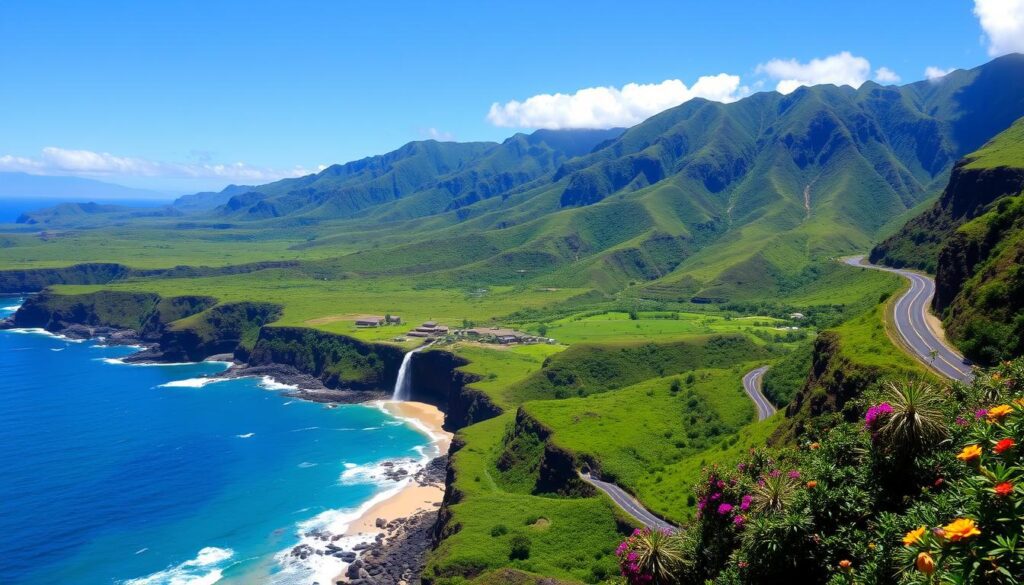
Maui, known as the “Valley Isle,” boasts a variety of microclimates across its regions. The sunny south coast near Wailea enjoys consistently pleasant Maui weather. In contrast, the west side around Lahaina, Kaanapali, and Kapalua receives more Maui rainfall.
South Maui’s Sunshine and West Maui’s Beauty
The leeward slopes of southern and southwestern Maui receive less Maui rainfall. This is due to descending trade winds, leading to clearer skies and warmer Maui temperatures. On the other hand, the windward east side, including the scenic Hana region, is wetter. This creates the beautiful waterfalls and lush rainforests.
Visitors should prepare for cooler temperatures when reaching the top of Haleakala volcano. It can reach over 10,000 feet in elevation. Temperatures there can drop below freezing, with occasional snowfall.
Maui’s Maui microclimates range from desert conditions in Lahaina, Kihei, and other areas to rainforest conditions in Haiku, Hana, and Kipahulu. Weather patterns vary by season, from warm, dry summers to cooler, wetter winters. This is when humpback whales migrate to the island’s waters.
Exploring Maui’s lush, verdant landscapes or sun-drenched beaches offers an unforgettable experience. Its diverse Maui weather and stunning natural beauty make it a standout destination.
Kauai: Garden Isle Rainbows and Waterfalls
Kauai, known as the “Garden Isle,” is a lush Hawaiian paradise. It attracts visitors with its varied microclimates and weather. The island’s temperatures stay warm, ranging from the upper 70s to the mid-80s Fahrenheit. However, rainfall varies greatly across different areas.
North Shore Showers and East Side Sunshine
The northern and eastern sides of Kauai, like Princeville and Hanalei, get more rain. High elevations, such as Mount Wailaleale, receive over 400 inches of rain annually. This makes the area a lush, waterfall-filled paradise.
On the other hand, the western and southern coasts are drier. Some areas get less than 20 inches of rain each year. This creates a unique microclimate, perfect for outdoor activities and sunbathing in areas like Poipu and Kapaa.
Kauai’s weather is shaped by trade winds, which bring showers to the windward side in summer. These showers are less intense than winter rains, caused by various storms.
Despite varied rainfall, Kauai’s ocean temperature stays at 78°F, ideal for swimming all year. The island’s diverse microclimates and natural wonders make it a top destination. It’s perfect for exploring the weather and landscapes of the Hawaiian islands.
Hawaii Weather by Month
Hawaii’s tropical climate means warm temperatures all year, with highs from 78°F to 88°F and lows from 65°F to 75°F. Weather patterns across the islands change with the seasons. April to October is drier, while November to March is wetter.
Rainfall in Hawaii is unpredictable and varies by location. The windward and leeward sides of the islands have different weather. In Honolulu, Hilo, and Kahului, temperatures range from 65°F to 90°F. Honolulu is usually the warmest.
In January, Honolulu’s average high is 79°F. Hilo and Kahului are slightly cooler, at 79°F and 80°F, respectively. The average lows are 64°F to 76°F. Honolulu gets 7.3 days of rain in January, with 2.4 inches of rainfall. Hilo and Kahului see 8.2 and 6.4 days of rain, with 4.5 and 1.8 inches of rain.
The Hawaii weather by month, Hawaii monthly weather, and Hawaii seasonal weather patterns offer a wide range of experiences. From the dry, sunny summer months to the cooler, wetter winters, there’s something for everyone. Knowing these seasonal variations helps plan the perfect Hawaiian trip.
The Big Island: Diverse Climates Within One Island
The Big Island of Hawaii is home to the most varied climates in the Hawaiian archipelago. It features 11 of the world’s 13 climate zones. This diversity is mainly due to the protective effect and height of its massive volcanoes, Mauna Kea and Mauna Loa.
Dry Kona and Kohala Coasts vs. Wet Hilo
The Kona and Kohala coasts on the western side are known for their sunny and dry conditions. Temperatures here range from 79°F to 88°F annually. On the other hand, the eastern side around Hilo sees more rainfall throughout the year. The wettest months are from November to March.
Temperatures on the Big Island vary greatly with elevation. At higher elevations, like Mauna Kea and Mauna Loa’s summits, it’s much cooler. Winter nights can drop below freezing, while summer days rarely exceed the low 60s Fahrenheit.
The Big Island’s microclimates are incredibly diverse. From the tropical rainforests of the east to the arid deserts of the north, and the temperate zones inland, it offers a unique weather experience. Knowing these varied conditions helps travelers plan their activities and pack for their Big Island adventure.
Lanai and Molokai: Peaceful Island Escapes
The smaller islands of Lanai and Molokai offer a serene escape for travelers. They have unique microclimates, providing a distinct weather experience compared to the rest of Hawaii.
Lanai Weather: Lanai’s highlands have a mild, cooler climate, while the coastal areas are warmer and sunnier. The island’s diverse topography, including lush forests and rugged terrain, contributes to its varied weather patterns. Visitors can expect comfortable temperatures year-round, making Lanai an ideal destination for those seeking a peaceful and temperate island experience.
Molokai Weather: Molokai’s weather is relatively consistent, with the northern and eastern sides receiving slightly more rainfall than the southern and western areas. This creates a more balanced and predictable climate, allowing visitors to enjoy the island’s stunning natural beauty without the dramatic weather fluctuations found on some of the larger Hawaiian islands.
- Lanai’s highlands experience a cooler, mild climate, while the coastal areas enjoy warmer, sunnier weather.
- Molokai’s weather is relatively consistent, with the northern and eastern sides receiving more rainfall than the southern and western sides.
- Both Lanai and Molokai offer a more peaceful island escape compared to the larger Hawaiian islands.
Whether you’re seeking a serene retreat or a unique weather experience, Lanai and Molokai provide the perfect balance. They offer a tranquil escape, catering to travelers who desire a more intimate and authentic Hawaiian adventure.
Best Time for Outdoor Activities
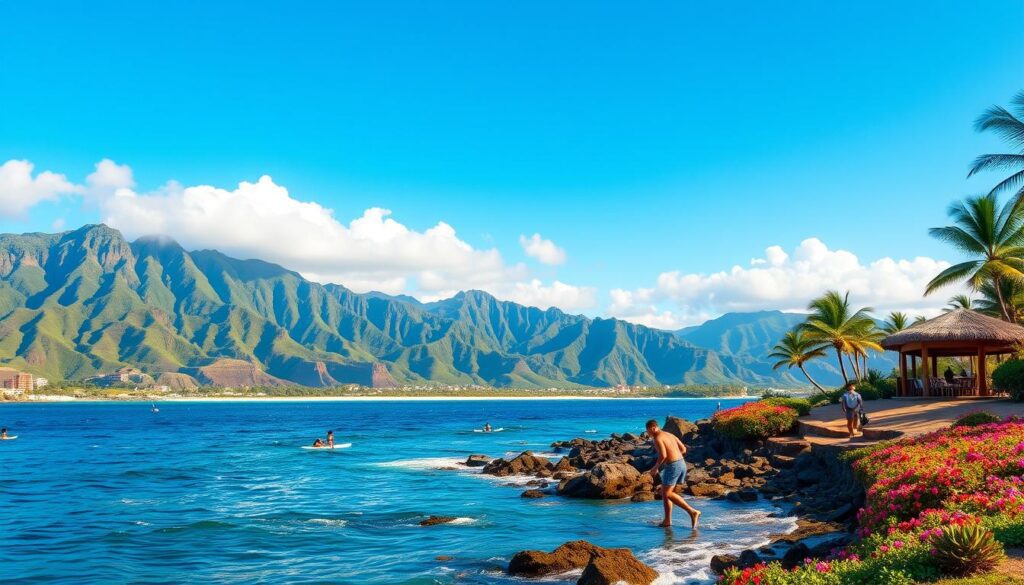
Hawaii’s tropical climate is perfect for outdoor activities all year. Yet, some seasons are better for certain activities. The dry months, from April to October, are ideal for water sports like swimming, snorkeling, and surfing. On the other hand, the wetter months from November to March are best for whale watching and enjoying the dramatic winter waves on the north shores. Hikers should be ready for muddy trails during these months.
Fall Weather (September – November)
- Average temperatures ranging between 78°F and 82°F.
- Lower rainfall compared to other seasons.
- Suitable for outdoor activities like hiking, snorkeling, and surfing.
- Events such as Aloha Festivals and Hawaii Food and Wine Festival.
Visiting Hawaii in September
September offers comfortable temperatures around 80°F, ideal for hiking and snorkeling. The Aloha Festivals and Okinawan Festival are also happening during this time.
Visiting Hawaii in October
October brings cooler temperatures, high 70s to low 80s, perfect for hiking. The warm water makes it great for water sports. The Hawaii Food and Wine Festival and Ironman World Championship are also in October.
Visiting Hawaii in November
November has pleasant weather, mid-70s to low 80s. It’s a good time for outdoor activities. The Hawaii International Film Festival and Kona Coffee Cultural Festival are happening then.
Winter Weather (December – February)
- Temperatures range between 73°F and 81°F.
- Increased rainfall but lush, green landscapes.
- Busy tourist season due to those escaping cold weather.
- Best time for whale watching and surfing competitions.
Visiting Hawaii in December
December’s mid-70s temperatures are great for outdoor activities. Christmas celebrations and Pearl Harbor Day are also happening.
Visiting Hawaii in January
January’s mid-70s temperatures and fewer tourists make it a good time. It’s a wet month, perfect for whale watching. The Sony Open Golf Tournament and the start of whale season are also in January.
Visiting Hawaii in February
February’s high 70s temperatures are mild. The Honolulu Festival and Maui Whale Festival are happening then.
Spring Weather (March-May)
- Temperatures between 74°F and 83°F.
- Ideal for vacation with less rainfall and affordable accommodations.
- Popular tourist months with events like Honolulu Festival and Merrie Monarch Hula Competition.
Visiting Hawaii in March
March’s temperatures, between 72-80°F, are perfect for outdoor activities. There’s a chance of rain and winter storms. Whale-watching tours and Prince Kuhio Festival are happening then.
Visiting Hawaii in April
April’s average temperatures around 80 degrees are great for outdoor activities. It’s drier than previous months. The Merrie Monarch Festival and Annual Waikiki Spam Jam are also in April.
Visiting Hawaii in May
May’s temperatures in the high 70s to low 80s are ideal for beach activities and road trips. The Lei Day Celebration and Lantern Floating Hawaii Ceremony are happening then.
Summer Weather (June – August)
- Temperatures between 81°F and 86°F, suitable for beach activities.
- Peak tourist season leading to higher prices for accommodations.
- Events like Pan-Pacific Festival and Hawaii International Film Festival.
Visiting Hawaii in June
June’s weather, between 80 and 85 degrees Fahrenheit, is perfect for outdoor activities. It’s a time to celebrate the culture and traditions of the islands, including King Kamehameha Day.
In summary, Hawaii offers a variety of outdoor activities all year. The drier months, April through October, are best for water sports. The wetter months, November through March, are ideal for whale watching and enjoying the dramatic winter waves. Hikers should be prepared for muddy trails during the wetter months.
Hawaii Weather Patterns and Climate Change
Climate change is reshaping Hawaii’s weather, moving away from its traditional tropical consistency. The islands now face more unpredictable and intense weather, including heavier rains, stronger storms, and temperature swings. These changes are altering the state’s climate significantly.
Recent data shows alarming trends for Hawaii’s weather future. In 2015 and 2016, Hawaii experienced its warmest years on record, with temperatures 2 degrees Fahrenheit higher than in 1950. Honolulu set new high temperature records three times in 2019, marking the hottest year in the city’s history. Even in 2022, a La Niña year, temperatures continued to rise, indicating rapid global warming.
The rising temperatures are severely impacting Hawaii’s ecosystems and microclimates. Marine heatwaves have doubled since 1982, threatening the state’s coral reefs. Warmer waters stress these reefs, while hotter summers favor invasive species, disrupting native forests and increasing wildfire risks.
Climate change’s effects in Hawaii go beyond temperature changes. Warmer seas lead to irregular weather, straining Hawaii’s energy and water systems. Rising sea levels pose a significant threat, potentially causing economic losses of up to $1.3 billion annually by 2050 if coral reefs decline further.
Travelers planning visits to Hawaii must stay updated on weather forecasts and be ready for travel disruptions. The state’s unique geography and diverse microclimates require visitors to research climate change impacts on their activities and destinations.
| Statistic | Value |
|---|---|
| Warmest years on record in Hawaii | 2015 and 2016 |
| Increase in average air temperatures since 1950 | 2 degrees Fahrenheit |
| Hottest year recorded in Honolulu | 2019 |
| Estimated rate of global heating in Hawaii | 170 times faster than naturally expected |
| Increase in marine heatwave frequency since 1982 | Doubled |
| Potential economic losses due to coral reef decline by 2050 | Up to $1.3 billion per year |
Hawaii’s unique geography and diverse microclimates underscore the need for visitors to stay informed about climate change impacts. As the state faces the challenges of global warming, travelers must plan ahead and prepare for unpredictable weather events that could affect their vacations.
Tips for Packing and Preparing for Hawaii’s Weather
Planning a trip to the Hawaiian Islands requires packing for the tropical climate. The region enjoys warm temperatures all year, with highs from 75°F to 85°F. However, the islands have diverse microclimates, with temperatures differing by up to 15 degrees. This variation depends on elevation and location.
Pack lightweight, breathable clothing like shorts, t-shirts, and tank tops for comfort. A light jacket or sweater is handy for cooler evenings or higher areas like Haleakalā National Park on Maui. Don’t forget rainwear, including a compact rain jacket or umbrella, as unexpected showers can happen any time of the year.
Accessories like sunscreen, hats, and sunglasses are crucial for sun protection. Consider bringing water shoes or sandals for beach and coastal explorations. Being prepared for Hawaii’s weather allows travelers to enjoy all the island has to offer. Activities range from swimming and snorkeling to hiking and sightseeing.

Scott Sweeney is the creator of Virtual Hawaii 360. Scott is a professional marketer and a lifelong Hawaii enthusiast. Scott splits time between Oahu and Dayton, Ohio. In addition to his marketing endevours, he is also a published Ukulele musician.

